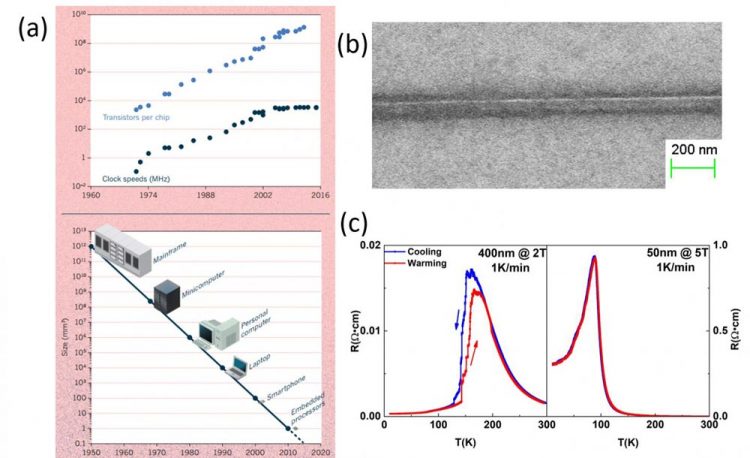Scientists reveal the dominant role of quenched disorder on complex oxide nanowires

(a) Moore's law: the number of transistors per microprocessor chip has roughly doubled every two years [1]. (b) a 100 nm manganite nanowire fabricated. (c) The transport properties of the nanowires showing significantly enhanced quenched disorder effects in 50 nm nanowire. Credit: ©Science China Press
In the article “Spatial confinement tuning of quenched disorder effects and enhanced magnetoresistance in manganite nanowires” published in SCIENCE CHINA Physics, Mechanics & Astronomy (First author: Yang Yu, Corresponding authors: Hangwen Guo, Lifeng Yin, Jian Shen), scientists has fabricated a series of complex oxide known as manganites nanowires ranging from 5 μm to 50 nm, by using state-of-the-art nanolithography techniques [Fig. 1b] [2].
From transport and magnetic imaging measurements, scientist reveals that when the nanowire size is smaller, the effect of quenched disorder becomes significantly enhanced—-a new phenomenon that has not been identified before at nanometer scale [Fig. 1c].
Quenched disorder: In condensed matter physics, quenched disorder usually refers to the randomness in a material which is “frozen” or “quenched” at all times. The most common source of quenched disorder comes from impurities or chemical dopants. Quenched disorder plays significant roles in complex oxide systems.
Extensive theoretical treatments have shown the critical role of quenched disorder in complex oxide systems such as high-Tc cuprates and colossal magnetoresistive manganites.
Experimental investigations, on the other hand, are rather complicated. The most common way to control quenched disorder is by chemical doping. However, chemical doping simultaneously alters material's chemical environments, structures, etc., clouding the impact of quenched disorder.
In this article, the scientist shows that spatial confinement is a clean and effective way to study quenched disorder effect without changing the chemical environments, structure and other physical parameters.
The results reveal that enhanced quenched disorder not only can alter the nature of electronic and magnetic phase transition, but increase the magnetoreisistance up to 820000 %, a 200 times enhancement to its original values. These phenomena offer new routes on the understanding of complex materials at nanometer scales and their potential applications.
###
This work was supported by the National Key Research and Development Program of China (2016YFA0300702); Shanghai Municipal Natural Science Foundation (18JC1411400, 18ZR1403200, 17ZR1442600); the Program of Shanghai Academic Research Leader (18XD1400600, 17XD1400400); the China Postdoctoral Science Foundation (2016M601488, 2017T100265).
See the article:
Yang Yu, Qiang Li, Qian Shi, YinYan Zhu, HanXuan Lin, Hao Liu, HongYan Chen, Tian Miao, Yu Bai, YanMei Wang, WenTing Yang, WenBin Wang, HangWen Guo, LiFeng Yin, and Jian Shen. Spatial confinement tuning of quenched disorder effects and enhanced magnetoresistance in manganite nanowires. Sci. China-Phys. Mech. Astron. 63, 237811 (2020).
http://engine.
[1] M. M. Waldrop, Nature 530, 144 (2016).
[2] Y. Yu, Q. Li, Q. Shi, Y. Y. Zhu, H. X. Lin, H. Liu, H. Y. Chen, T. Miao, Y. Bai, Y. M. Wang, W. T. Yang, W. B. Wang, H. W. Guo, L. F. Yin, and J. Shen, Sci. China-Phys. Mech. Astron. 63, 237811 (2020).
Media Contact
More Information:
http://dx.doi.org/10.1007/s11433-019-1444-6All latest news from the category: Power and Electrical Engineering
This topic covers issues related to energy generation, conversion, transportation and consumption and how the industry is addressing the challenge of energy efficiency in general.
innovations-report provides in-depth and informative reports and articles on subjects ranging from wind energy, fuel cell technology, solar energy, geothermal energy, petroleum, gas, nuclear engineering, alternative energy and energy efficiency to fusion, hydrogen and superconductor technologies.
Newest articles

Silicon Carbide Innovation Alliance to drive industrial-scale semiconductor work
Known for its ability to withstand extreme environments and high voltages, silicon carbide (SiC) is a semiconducting material made up of silicon and carbon atoms arranged into crystals that is…

New SPECT/CT technique shows impressive biomarker identification
…offers increased access for prostate cancer patients. A novel SPECT/CT acquisition method can accurately detect radiopharmaceutical biodistribution in a convenient manner for prostate cancer patients, opening the door for more…

How 3D printers can give robots a soft touch
Soft skin coverings and touch sensors have emerged as a promising feature for robots that are both safer and more intuitive for human interaction, but they are expensive and difficult…





















